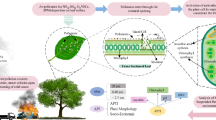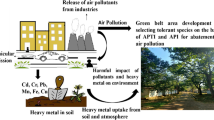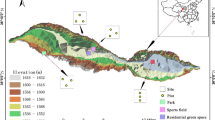Abstract
For urban ecosystem, the understanding of plant responses and behavioral pattern to prevailing stresses is critical. This study aims to evaluate the reproductive behavior of 40 roadside plants, including trees, shrubs, and herbs, to higher air pollution load for three successive years (i.e.—2017, 2018, and 2019) in an Indo-gangetic urban sprawl. The mean surface concentration of three gaseous pollutants (O3, NO2, and SO2) and one particulate matter with aerodynamic diameter ≤ 1 µm (PM1) was found to be highest at the polluted sites during all seasons. Though, there is no prescribed national standard for total atmospheric deposition; but, it was found significantly higher in all the seasons at the urban sites. According to obtained results, the natural pollen viabilities in all the plant species decreased to 10% significantly earlier at the urban sites. The seed numbers, weight, viability, and in-vivo germinations were also reduced significantly under higher air pollution load. The K-means cluster including all obtained data demonstrated a major group of 36 plants followed by two out groups of 2 plants each. Exceptionally, few plants, such as M. indica, R. communis, S. sisymbrifolium, M. azedarach, H. indicum, J. gossypifolia, S. tora, A. indicum, and C. gigantea, showed improved or unaffected responses in some of the reproductive parameters under higher air pollution load. Altogether, the obtained responses of all these plant species might be useful to understand the reproductive strategies, and can be utilized towards screening of effective species for sustainable urban green space development.





Similar content being viewed by others
References
Adaros, G., Weigel, H. J., & Jäger, H. J. (1991). Single and interactive effects of low levels of O3, SO2 and NO2 on the growth and yield of spring rape. Environmental Pollution, 72(4), 269–286. https://doi.org/10.1016/0269-7491(91)90002-E
Agrawal, M., Singh, B., Agrawal, S. B., Bell, J. N. B., & Marshall, F. (2006). The effect of air pollution on yield and quality of mung bean grown in peri-urban areas of Varanasi. Water, Air, and Soil Pollution, 169, 239–254. https://doi.org/10.1007/s11270-006-2237-6
Aliyar, Z. B., Shafiei, A. B., Seyedi, N., Rezapour, S., & Moghanjugi, S. M. (2020). Effect of traffic-induced air pollution on seed germination of Arizona Cypress (Cupressus arizonica Green) and Black Pine (Pinus nigra Arnold). Urban Forestry & Urban Greening, 55, 126841. https://doi.org/10.1016/j.ufug.2020.126841
Amundson, R. G. (1983). Yield reduction of soybean due to exposure to sulfur dioxide and nitrogen dioxide in combination. Journal of Environmental Quality, 12(4), 454–459. https://doi.org/10.2134/jeq1983.00472425001200040003x
Bosac, C., Black, V. J., Roberts, J. A., & Black, C. R. (1998). Impact of ozone on seed yield and quality and seedling vigour in oilseed rape (Brassica napus L.). Journal of Plant Physiology, 153(1–2), 127–134. https://doi.org/10.1016/S0176-1617(98)80055-2
Byers, D. H., & Saltzman, B. E. (1958). Determination of ozone in air by neutral and alkaline iodide procedures. American Industrial Hygiene Association Journal, 19(3), 251–257. https://doi.org/10.1080/00028895809343585
Census of India. Ministry of Home Affairs, Government of India (2011). Retrieved from 12 Feb 2023. Available online: https://censusindia.gov.in/2011census/PCA/A4.html.
Central Pollution Control Board, Ministry of Environment & Forests, Government of India. (2011). Guidelines for the measurement of ambient air pollutants. Retrieved from 28 Feb 2023. https://cpcb.nic.in/openpdffile.php?id=UmVwb3J0RmlsZXMvMjdfMTQ1ODExMDQyNl9OZXdJdGVtXzE5Nl9OQUFRTVNfVm9sdW1lLUkucGRm.
Chakraborty, A., & Gupta, T. (2010). Chemical characterization and source apportionment of submicron (PM1) aerosol in Kanpur region, India. Aerosol Air Quality Research, 10, 433–445. https://doi.org/10.4209/aaqr.2009.11.0071
Chaudhary, I. J., & Rathore, D. (2019). Dust pollution: Its removal and effect on foliage physiology of urban trees. Sustainable Cities and Society, 51, 101696. https://doi.org/10.1016/j.scs.2019.101696
Darbah, J. N., Kubiske, M. E., Nelson, N., Oksanen, E., Vapaavuori, E., & Karnosky, D. F. (2008). Effects of decadal exposure to interacting elevated CO2 and/or O3 on paper birch (Betula papyrifera) reproduction. Environmental Pollution, 155(3), 446–452. https://doi.org/10.1016/j.envpol.2008.01.033
Das, S., & Sarkar, A. (2022). Utilization of mango plants (Mangifera indica L.) as in situ bio-monitoring tool against vehicular air pollution along National and State Highways: A case study from Malda district, West Bengal, India. Journal of Biology and Today’s World, 11(3), 1–4.
Das, S., Sarkar, A., Mina, U., Nandy, S., Saadat, M. N., Agrawal, G. K., & Rakwal, R. (2022). Trends in summer-time tropospheric ozone during covid-19 lockdown in Indian cities might forecast a higher future risk. Atmosphere, 13(7), 1115. https://doi.org/10.3390/atmos13071115
De Storme, N., & Geelen, D. (2014). The impact of environmental stress on male reproductive development in plants: Biological processes and molecular mechanisms. Plant, Cell & Environment, 37(1), 1–18. https://doi.org/10.1111/pce.12142
Dong, D., & Wang, J. (2023). Air pollution as a substantial threat to the improvement of agricultural total factor productivity: Global evidence. Environment International, 173, 107842. https://doi.org/10.1016/j.envint.2023.107842
Duque, L., Poelman, E. H., & Steffan-Dewenter, I. (2021). Effects of ozone stress on flowering phenology, plant-pollinator interactions and plant reproductive success. Environmental Pollution, 272, 115953. https://doi.org/10.1038/s41598-021-02878-9
Farooqi, Z. R., Iqbal, M. Z., Kabir, M., & Shafiq, M. (2009). Toxic effects of lead and cadmium on germination and seedling growth of Albizia lebbeck (L.) Benth. Pakistan Journal of Botany, 41(1), 27–33.
Fuller, R., Landrigan, P. J., Balakrishnan, K., Bathan, G., Bose-O’Reilly, S., Brauer, M., Caravanos, J., Chiles, T., Cohen, A., Corra, L., Cropper, M., Ferraro, G., Hanna, J., Hanrahan, D., Hu, H., Hunter, D., Janata, G., Kupta, R., Lanphear, B., … Yan, C. (2022). Pollution and health: a progress update. The Lancet Planetary Health. https://doi.org/10.1016/S2542-5196(22)00090-0
Ganatsas, P., Tsakaldimi, M., & Zachariadis, G. (2011). Effect of air traffic pollution on seed quality characteristics of Pinus brutia. Environmental and Experimental Botany, 74, 157–161. https://doi.org/10.1016/j.envexpbot.2011.05.014
Gillespie, C., Stabler, D., Tallentire, E., Goumenaki, E., & Barnes, J. (2015). Exposure to environmentally-relevant levels of ozone negatively influence pollen and fruit development. Environmental Pollution, 206, 494–501. https://doi.org/10.1016/j.envpol.2015.08.003
Gottardini, E., Cristofolini, F., Paoletti, E., Lazzeri, P., & Pepponi, G. (2004). Pollen viability for air pollution bio-monitoring. Journal of Atmospheric Chemistry, 49(1), 149–159. https://doi.org/10.1007/s10874-004-1221-z
Hammami, H., Parsa, M., Bayat, H., & Aminifard, M. H. (2022). The behavior of heavy metals in relation to their influence on the common bean (Phaseolus vulgaris) symbiosis. Environmental and Experimental Botany, 193, 104670. https://doi.org/10.1016/j.envexpbot.2021.104670
Hatfield, J. L., & Prueger, J. H. (2015). Temperature extremes: Effect on plant growth and development. Weather and Climate Extremes, 10, 4–10. https://doi.org/10.1016/j.wace.2015.08.001
Iannotti, O., Mincigrucci, G., Bricchi, E., & Frenguelli, G. (2000). Pollen viability as a bio-indicator of air quality. Aerobiologia, 16(3), 361–365. https://doi.org/10.1023/A:1026559602547
Jacobs, M. B., & Hochheiser, S. (1958). Continuous sampling and ultramicro determination of nitrogen dioxide in air. Analytical Chemistry, 30(3), 426–428. https://doi.org/10.1021/ac60135a032
**, X., & Han, J. (2011). K-means clustering. In C. Sammut & G. I. Webb (Eds.), Encyclopedia of machine learning. Boston: Springer.
Joshi, O. P., & Sikka, J. (2002). Floral response of some tree species to air pollution. Pollution Research, 21(4), 417–419.
Kanawade, V. P., Srivastava, A. K., Ram, K., Asmi, E., Vakkari, V., Soni, V. K., Varaprasad, V., & Sarangi, C. (2020). What caused severe air pollution episode of November 2016 in New Delhi? Atmospheric Environment, 222, 117125. https://doi.org/10.1016/j.atmosenv.2019.117125
Kilkenny, F. F., & Galloway, L. F. (2008). Reproductive success in varying light environments: Direct and indirect effects of light on plants and pollinators. Oecologia, 155, 247–255. https://doi.org/10.1007/s00442-007-0903-z
Kumari, N. (2018). Effects of pollutants on seed germinability, reproductive capacity and yield of mustard plant. International Journal of Chemical Studies, SP4, 96-98. P-ISSN: 2349–8528. E-ISSN: 2321–4902.
Levy, J. I., & Hanna, S. R. (2011). Spatial and temporal variability in urban fine particulate matter concentrations. Environmental Pollution, 159(8–9), 2009–2015. https://doi.org/10.1016/j.envpol.2010.11.013
Liem, A. S., & Groot, J. (1973). Anthesis and pollen dispersal of Holcus lanatus L. and Festuca rubra L. in relation to climate factors. Review of Palaeobotany and Palynology, 15(1), 3–16. https://doi.org/10.1016/0034-6667(73)90012-2
Lin, J., Zhao, L., & Wang, X. (2018). Influencing factors of the acceptable amount of compensation of farmers for controlling fertilizer-induced water pollution. Environmental Engineering & Management Journal, 17(8), 2011–2022.
Mandal, M., Popek, R., Przybysz, A., Roy, A., Das, S., & Sarkar, A. (2023). Breathing fresh air in the city: Implementing avenue trees as a sustainable solution to reduce particulate pollution in urban agglomerations. Plants, 12(7), 1545. https://doi.org/10.3390/plants12071545
Marshall, F., Ashmore, M., & Hinchcliffe, F. (1997). A hidden threat to food production: Air pollution and agriculture in the develo** world. International Institute for Environment and Development.
Molnár, V. É., Simon, E., Tóthmérész, B., Ninsawat, S., & Szabó, S. (2020). Air pollution induced vegetation stress–the air pollution tolerance index as a quick tool for city health evaluation. Ecological Indicators, 113, 106234. https://doi.org/10.1016/j.ecolind.2020.106234
National highways authority of india, ministry of road transport and highways (2017). Memo No- 63013/1/2017-18/OTHS/Misc/103/1461.
Ouyang, Y., Xu, Z., Fan, E., Li, Y., & Zhang, L. (2016). Effect of nitrogen dioxide and sulfur dioxide on viability and morphology of oak pollen. International Forum of Allergy & Rhinology, 6(1), 95–100. https://doi.org/10.1002/alr.21632
Pasqualini, S., Tedeschini, E., Frenguelli, G., Wopfner, N., Ferreira, F., D’Amato, G., & Ederli, L. (2011). Ozone affects pollen viability and NAD (P) H oxidase release from Cupressus arizonica pollen. Environmental Pollution, 159(10), 2823–2830. https://doi.org/10.1016/j.envpol.2011.05.003
Pereira, S., Fernández-González, M., Guedes, A., Abreu, I., & Ribeiro, H. (2021). The strong and the stronger: the effects of increasing ozone and nitrogen dioxide concentrations in pollen of different forest species. Forests, 12(1), 88. https://doi.org/10.3390/f12010088
R Core Team. (2022). R: A language and environment for statistical computing. R Foundation for Statistical Computing.
Ramírez-Aliaga, P., Foyo-Moreno, I., & Cariñanos, P. (2022). Effects of Environmental Stress on the Pollen Viability of Ornamental Tree-Species in the City of Granada (South-Eastern Spain). Forests, 13(12), 2131. https://doi.org/10.3390/f13122131
Rezanejad, F. (2008). The structure and ultra-structure of anther epidermis and pollen in Lagerstroemia indica L. (Lythraceae) in response to air pollution. Turkish Journal of Botany, 32(1), 35–42.
Ríos, B., Torres-Jardón, R., Ramírez-Arriaga, E., Martínez-Bernal, A., & Rosas, I. (2016). Diurnal variations of airborne pollen concentration and the effect of ambient temperature in three sites of Mexico City. International Journal of Biometeorology, 60, 771–787. https://doi.org/10.1007/s00484-015-1061-3
Roy, A., Bhattacharya, T., & Kumari, M. (2020). Air pollution tolerance, metal accumulation and dust capturing capacity of common tropical trees in commercial and industrial sites. Science of the Total Environment, 722, 137622. https://doi.org/10.1016/j.scitotenv.2020.137622
Sarkar, A., & Das, S. (2021). urban air pollution and avenue trees: Benefits interactions and future prospects. Nova Science publishers.
Sarkar, A., Singh, A. A., Agrawal, S. B., Ahmad, A., & Rai, S. P. (2015). Cultivar specific variations in antioxidative defense system, genome and proteome of two tropical rice cultivars against ambient and elevated ozone. Ecotoxicology and Environmental Safety, 115, 101–111. https://doi.org/10.1016/j.ecoenv.2015.02.010
Shafiq, M., & Iqbal, M. Z. (2012). Effect of autoexhaust emission on germination and seedling growth of an important arid tree Cassia siamea Lamk. Emirates Journal of Food and Agriculture, 24(3), 234.
Shafiq, M., Shahid, H., Iqbal, M. Z., Kabir, M., & Farooqi, Z. R. (2019). Effects of auto exhaust emission on germination and certain seedling growth parameter of Sesbania grandiflora (L.) Poiret (humming bird tree). COJ Technical & Scientific Research, 1, 1–8. https://doi.org/10.31031/COJTS.2019.01.000524
Sillmann, J., Aunan, K., Emberson, L., Büker, P., Van Oort, B., O’Neill, C., Otero, N., Pandey, D., & Brisebois, A. (2021). Combined impacts of climate and air pollution on human health and agricultural productivity. Environmental Research Letters, 16(9), 093004. https://doi.org/10.1088/1748-9326/ac1df8
Singh, R. K., & Agrawal, M. (2005). Atmospheric depositions around a heavily industrialized area in a seasonally dry tropical environment of India. Environmental Pollution, 138(1), 142–152. https://doi.org/10.1016/j.envpol.2005.02.009
Srimuruganandam, B., & Nagendra, S. S. (2012). Source characterization of PM10 and PM2.5 mass using a chemical mass balance model at urban roadside. Science of the Total Environment, 433, 8–19. https://doi.org/10.1016/j.scitotenv.2012.05.082
Sun, S., **, J., **a, M., Liu, Y., Gao, M., Zou, C., Wang, T., Lin, Y., Wu, L., Mao, H., & Wang, P. (2020). Vehicle emissions in a middle-sized city of China: Current status and future trends. Environment International, 137, 105514. https://doi.org/10.1016/j.envint.2020.105514
Szymańska, R., Ślesak, I., Orzechowska, A., & Kruk, J. (2017). Physiological and biochemical responses to high light and temperature stress in plants. Environmental and Experimental Botany, 139, 165–177. https://doi.org/10.1016/j.envexpbot.2017.05.002
Ugale, C., & Tidke, J. A. (2022). Air pollution effects on Datura innoxia mill. pollen structure, protein and germination. Aerobiologia, 38(3), 379–390. https://doi.org/10.1007/s10453-022-09753-8
Van Waes, J. M., & Debergh, P. C. (1986). Adaptation of the tetrazolium method for testing the seed viability, and scanning electron microscopy study of some Western European orchids. Physiologiaplantarum, 66(3), 435–442. https://doi.org/10.1111/j.1399-3054.1986.tb05947.x
Wahid, A. (2006). Influence of atmospheric pollutants on agriculture in develo** countries: A case study with three new varieties in Pakistan. Science of the Total Environment, 371, 304–313. https://doi.org/10.1016/j.scitotenv.2006.06.017
Wei, W., & Wang, Z. (2021). Impact of industrial air pollution on agricultural production. Atmosphere, 12(5), 639. https://doi.org/10.3390/atmos12050639
Wei, Y., Wang, S., & Yu, D. (2023). The Role of light quality in regulating early seedling development. Plants, 12(14), 2746. https://doi.org/10.3390/plants12142746
West, P. W., & Gaeke, G. C. (1956). Fixation of sulfur dioxide as disulfitomercurate (II) and subsequent colorimetric estimation. Analytical Chemistry, 28(12), 1816–1819. https://doi.org/10.1021/ac60120a005
Ziaul, S., & Pal, S. (2018). analyzing control of respiratory particulate matter on land surface temperature in local climatic zones of english bazar municipality and surroundings. Urban Climate, 24, 34–50. https://doi.org/10.1016/j.uclim.2018.01.006
Acknowledgements
AS thankfully acknowledge the Department of Science & Technology and Biotechnology (DST&BT), Government of West Bengal, India for providing the financial support in the form of a research project (Memo No.: 207 (Sanc.)-ST/P/S&T/5G-14/2018, dated: 20 February 2019).
Author information
Authors and Affiliations
Contributions
All the authors have contributed to the article. SD: Methodology, Software, Formal analysis, Writing-Original draft. CB: Formal analysis, Data Curation, Visualization. AR: Writing-review and editing, Visualization. MM: Writing-review and editing, Visualization. RP: Methodology, Writing-review and editing, Visualization. AA: Data curation and analyses. AS: Conceptualization, Methodology, Writing-review and editing, Validation, Investigation, Resources. All the authors have read and approved the final draft of the manuscript.
Corresponding author
Ethics declarations
Competing interests
The authors declare no competing interests.
Conflict of interest
The authors declare that they have no known competing financial interests or personal relationships that could have appeared to influence the work reported in this paper.
Supplementary Information
Below is the link to the electronic supplementary material.
Rights and permissions
Springer Nature or its licensor (e.g. a society or other partner) holds exclusive rights to this article under a publishing agreement with the author(s) or other rightsholder(s); author self-archiving of the accepted manuscript version of this article is solely governed by the terms of such publishing agreement and applicable law.
About this article
Cite this article
Das, S., Barman, C., Roy, A. et al. Air pollution may alter reproductive dynamics/efficacy in plants: correlative evidences from an urban sprawl in Eastern Indo-Gangetic plain. Aerobiologia (2024). https://doi.org/10.1007/s10453-024-09811-3
Received:
Accepted:
Published:
DOI: https://doi.org/10.1007/s10453-024-09811-3




